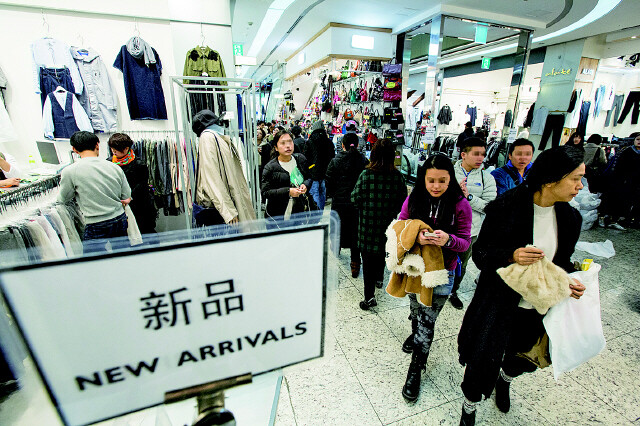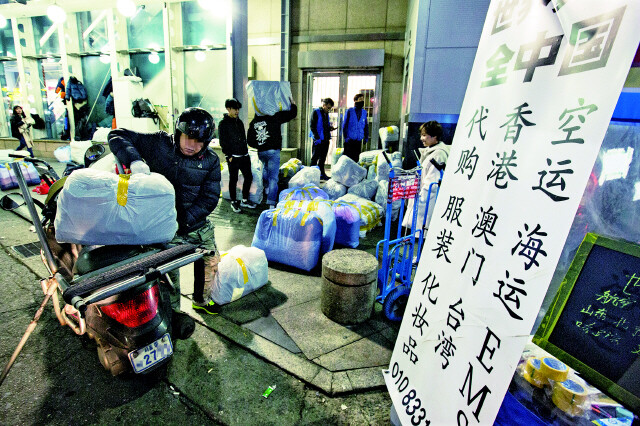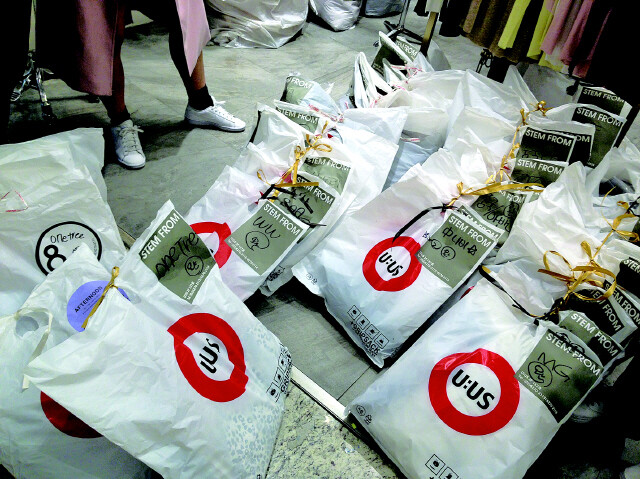hankyoreh
Links to other country sites 다른 나라 사이트 링크
[Reportage] At Dondaemun market, “China keeps us fed”, and poses a huge risk

It was 11:30 pm on Feb. 23, and the area around Yours rang boisterously with exchanges in Chinese between customers and employees at the wholesale mall in Seoul’s Dongdaemun neighborhood, where soft spring clothes lay out on display.
“Kan yixia.” (看一下, Have a look)
“Lanse, baise.” (蓝色、白色,Blue and white)
“Mei you.” (没有,We don’t have it)
“Xinkuan.” (新款, New item)

A few South Korean merchants could be seen walking around with large purchase bags on their backs, but the Chinese merchants seemed to be dominating. Many dragged around travel cases instead of the bags - the Chinese retailers the locals call “haendeu kaeri,” or “hand-carry sellers.”
Historically, the first Chinese customers at Dongdaemun’s shopping district were major wholesale traders from Guangzhou, a port city where clothes merchants were said to congregate from all over the country. Today, individual retailers fly in from cities all over inland China. Like the clothing store owners from South Korean regional cities like Gangneung and Cheongju who come for spring clothes, small-scale shop owners from Beijing, Hangzhou, Qingdao, and elsewhere are flocking to Dongdaemun to pick up spring items wholesale.
For decades, Dongdaemun Market has been the avenue to supply clothing stores around the country with the fastest and cheapest popular fashions. Some have called it home of the “protoplasm” for the fast fashion trend that has taken off worldwide.
The big wheels here are ultimately the wholesale traders. The area is home to five to six retail malls like Doota and Migliore, but the Dongdaemun mainstream lies in its thirty or so wholesale malls, crammed with stores in the tens of thousands. Each has two or three designers, with less than a week‘s turnaround from product planning to launch. Another asset is a system for small-scale production of multiple items, capable of cranking out a single item in batches of 30.

Chinese merchants flock to fast fashion hub
The spring items made here are now out of Dongdaemun’s stores and into a South Korea-China “fast trade” system that will have them on Beijing racks in as little as two days. Individual visa issuance conditions were significantly loosened last year, and with the won-to-yuan exchange rate higher than average recently, Chinese traders are finding Dongdaemun a good place to snag spring wares. The "Korean Wave” in popular culture has further boosted the popularity of South Korean fashions in China. In short, all the conditions are there for Chinese retailers to flock to the market.
A 43-year-old customer surnamed Yu said she had come to South Korea for the first time for a five-day trip to buy the equivalent of around US$3,200 in items. In her hands were plastic bags from Yours and apM, both malls famous through word of mouth among Chinese wholesalers and retailers alike.
“It‘s my first time going overseas for items. A friend of mine who had been to Dongdaemun before suggested we go together, so I followed along,” explained Yu, who identified herself as a merchant from China’s Shandong Province.
“I‘ve found the quality satisfactory, so I’m planning to come again this summer,” she added.
Many of the Chinese retailers were younger people in their twenties and thirties who had come for “sensual” youthful styles. A 27-year-old from Zhejiang Province who identified himself by the surname Peng explained, “South Korean clothes are very popular at the mall where I sell, so I started coming to Dongdaemun last year.”
“This is my fifth visit,” he noted, adding that he planned to “come about once a month from now on.”
Liu Qiqi, 26, said she arrived with her husband from Hefei, Anhui Province, to pick up some wares.
“We’ve been coming regularly to pick up Dongdaemun items for the past several years,” Liu said.
“I’d been to South Korea so many times. I counted the number of passport stamps. This is the 105th,” she added.
Many of the Chinese wholesale and retail merchants visit Dongdaemun’s Dongbu Market, home to modern wholesale malls like Yours, apM, apM Luxe, and Designer’s Club. The side streets around the area house around 200 agencies where overseas and Korean-Chinese agents provide distribution and customs services for China. It‘s this business that explains all the signs around the wholesale malls that end in the Chinese characters for “maoyi” - meaning “trade.” The busiest hours for wholesalers come between 10 pm and midnight; Chinese merchants pick out the clothes they think will sell best at their stores, conducting their transactions in cash. Some pack travel trunks full of plastic bags of clothes, but many leave the bags at the wholesale shops with name tags or tickets attached.
As the wee hours descend on the wholesale market, the delivery workers - known locally as “the uncles” - begin to go around picking up piles of items from in front of the stores and delivering them to the agencies. By as early as 6 am, they will be on flights bound for China. By 8 am, they will arrive at Qingdao, Hangzhou, Jinan, or another of the cities known of late for swift customs clearance and low duties. The differing customs policies of Chinese local governments require close attention, and the agencies’ competitiveness lies in their ability to keep transportation costs down through swift access to information from authorities and cheap airline compartments. Items purchased around midnight can finish clearing customs in the morning and go out on the racks as spring items by afternoon in cities where customhouses are located; for bigger cities like Beijing, Shanghai, or Guangzhou, they typically arrive by the next morning. Even cities located far inland can still have their wares in two to three days.
Early on, most of the Chinese customers at Dongdaemun’s wholesale markets were merchants from Taiwan or Hong Kong. It was in 2009 that the market underwent sweeping changes as more and more mainland customers began flocking there. Before, the exchange rate had fluctuated around 120 won to one yuan. But the global financial crisis sent it skyrocketing - as high as 230 at one point in 2009. The stage was set for big exchange profits to be made.

Korean wave, cheap flights and looser visa conditions
The major players in Guangzhou, clothing suppliers to the rest of the mainland, were quick to take action. Dongdaemun fashions were already popular in China for their design sense. The growing Korean Wave added fuel to the fire, sending more and more Chinese merchants to the market. Even after the exchange rate settled to the range of 170 to 180 won to the yuan, wholesale jobbers from Hangzhou kept coming.
Those were the main factors in the growing dominance of Chinese retailers that began around two and a half years ago. Looser visa conditions and the proliferation of cheaper flights furthered fueled the trend - and show no signs of stopping soon.
“The big Guangzhou wholesalers would spend tens to hundreds of millions of won on items in one go. Now we’ve got Chinese retailers buying small - in the hundreds of thousands to millions of won - but there are a lot more Chinese merchants visiting the malls,” said Yu Seon-gyu, head of the management and planning team for Yours, which is considered one of the “big three” modern wholesale malls most visited by Chinese customers.
“Chinese merchants account for about seven out of every ten people who visit our mall, and I‘d estimate that about five of them are Chinese retailers,” Yu continued. “The Chinese merchants are basically making up for the slump with clothing stores in South Korean cities outside Seoul.”
One striking feature of the shopping mall landscape is the many visiting female merchants from China with their faces bandaged or freshly bruised from cosmetic surgery procedures in Seoul.
It’s in response to these changes that the ten or so modern wholesale malls in Dongdaemun have undergone a rapid evolution - the better to cater to their Chinese customers’ tastes. This includes mall representatives paying visits to wholesale merchants in China for marketing, along with efforts to build infrastructure: setting up packing centers for Chinese merchants, hiring Korean-Chinese staff, providing Mandarin interpretation services, and hanging up signs in Chinese.
Concern over deteriorating ties
The close ties between the Chinese and South Korean economies aren’t merely a matter of exports by large-scale manufacturers. A longstanding practice of recordless transactions means precise figures on the economic scale are unavailable, but tens of thousands of wholesale shops in the Dongdaemun fashion economic bloc - each operating from an area of around 9.9 square meters - do business estimated at over 10 trillion won (US$8.0 billion) with tiny clothing stores throughout the Chinese interior. It‘s a system where economies are interwoven like capillaries down to the lowest levels.
“Speed is key in fast fashion. Chinese wholesale and retail merchants typically use simplified customs procedures where they’re not paying formal duties, so customs policies at the Chinese central government and local government level become very important,” said the fifty-something overseas Chinese proprietor of one agency.
“Recently, agency heads here have been talking about crisis measures to deal with worsening South Korea-China relations over the THAAD issue, which doesn‘t show any signs of improving,” the proprietor continued, referring to frictions over the potential deployment of a Terminal High Altitude Area Defense anti-missile system with US Forces Korea.
“The same people saw how badly the Japanese tourism industry struggled after relations with Beijing there cooled a few years ago. I think a lot of this Dongdaemun trade would become very difficult if Chinese customs authorities decided to start doing everything by the book.”
Indeed, the Dongdaemun wholesale market already got a bitter taste of just how big China has become for it during last year’s Middle East Respiratory Syndrome (MERS) outbreak.
“We had always thought of our mall as a ‘Chinese place,’ but when the Chinese customers stopped coming for two months or so because of MERS, the whole place was so quiet. It really drove it home,” said a 30-year-old wholesale women‘s wear shop proprietor surnamed Lee.
“Sales for our store dropped by more than half, and they had to institute emergency measures like lowering the mall’s rental fees,” Lee recalled. “I came away thinking, ‘China keeps us fed, but that also means the China risk is that much greater.’”
As the clock ticked past 1 am, the crowds at Dongdaemun‘s wholesale mall began to thin out a bit. The voices of the Chinese customers, now tired and jittery, were still there - this time echoing from the cart bars and street stalls serving late-night snacks from the Dongdaemun alleys.
By Jung Se-ra, staff reporter
Please direct questions or comments to [english@hani.co.kr]
Editorial・opinion
![[Correspondent’s column] The real reason the US is worried about Chinese ‘overcapacity’ [Correspondent’s column] The real reason the US is worried about Chinese ‘overcapacity’](https://flexible.img.hani.co.kr/flexible/normal/500/300/imgdb/original/2024/0510/5217153290112576.jpg) [Correspondent’s column] The real reason the US is worried about Chinese ‘overcapacity’
[Correspondent’s column] The real reason the US is worried about Chinese ‘overcapacity’![[Editorial] Yoon’s gesture at communication only highlights his reluctance to change [Editorial] Yoon’s gesture at communication only highlights his reluctance to change](https://flexible.img.hani.co.kr/flexible/normal/500/300/imgdb/original/2024/0510/7717153284590168.jpg) [Editorial] Yoon’s gesture at communication only highlights his reluctance to change
[Editorial] Yoon’s gesture at communication only highlights his reluctance to change- [Editorial] Perilous stakes of Trump’s rhetoric around US troop pullout from Korea
- [Guest essay] Preventing Korean Peninsula from becoming front line of new cold war
- [Column] The state is back — but is it in business?
- [Column] Life on our Trisolaris
- [Editorial] Penalties for airing allegations against Korea’s first lady endanger free press
- [Editorial] Yoon must halt procurement of SM-3 interceptor missiles
- [Guest essay] Maybe Korea’s rapid population decline is an opportunity, not a crisis
- [Column] Can Yoon steer diplomacy with Russia, China back on track?
Most viewed articles
- 1[Correspondent’s column] The real reason the US is worried about Chinese ‘overcapacity’
- 2[Book review] Who said Asians can’t make some good trouble?
- 3[Column] “Hoesik” as ritual of hierarchical obedience
- 4Behind bellicose bluster, N. Korea is turning airfields into greenhouse farms
- 5[Editorial] Penalties for airing allegations against Korea’s first lady endanger free press
- 6Yoon rejects calls for special counsel probes into Marine’s death, first lady in long-awaited presse
- 7[Editorial] Human trafficking in S. Korea
- 8Yoon’s broken-compass diplomacy is steering Korea into serving US, Japanese interests
- 9In Yoon’s Korea, a government ‘of, by and for prosecutors,’ says civic group
- 10Filipinas forced into prostitution on the rise in S.Korea